Doctor says leg-lengthening surgery is increasingly popular among men who wish to be taller
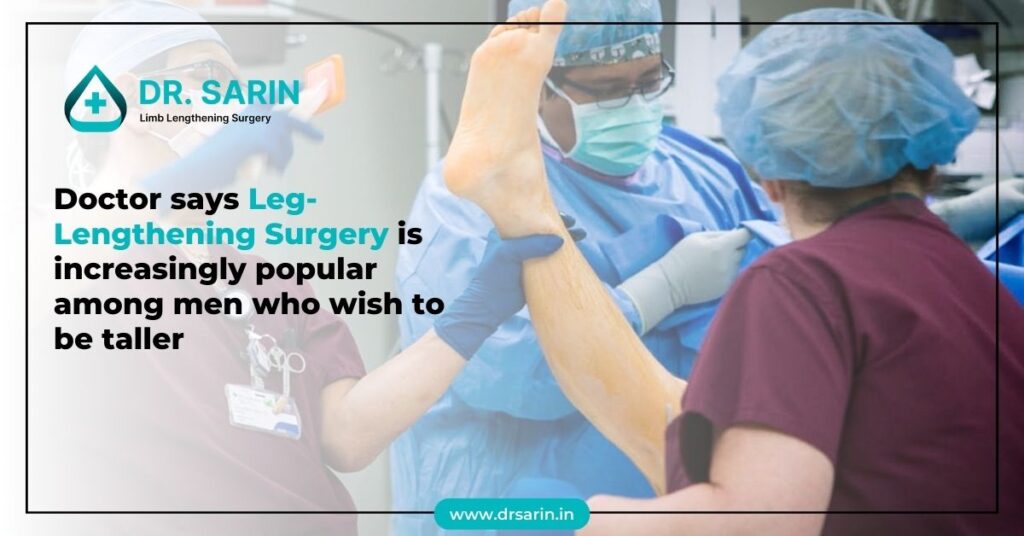
Leg-lengthening surgery, once primarily associated with medical necessity, is now gaining popularity among men who desire to increase their height for cosmetic reasons. This trend reflects evolving societal attitudes towards body image and masculinity. In recent years, there has been a noticeable surge in men opting for leg-lengthening surgery to achieve a taller stature. Driven by societal pressures and personal insecurities, many perceive increased height as a pathway to enhanced confidence, social acceptance, and romantic opportunities. Traditionally, leg-lengthening surgery, also known as limb lengthening or distraction osteogenesis, was performed to correct limb length discrepancies resulting from congenital conditions, injuries, or medical ailments such as dwarfism. However, advancements in surgical techniques have expanded the application of this procedure to individuals seeking cosmetic enhancements. The surgical process typically involves making controlled leg bone fractures and then gradually stretching the bone segments using external fixators or internal implants. Over several months, new bone tissue fills in the gaps created by the stretching, resulting in increased bone length. While surgery can offer physical transformation and improve self-esteem for some individuals, it is not without risks and challenges. The procedure is invasive and requires significant commitment from patients, including prolonged recovery periods and intensive rehabilitation. Moreover, the psychological impact of undergoing elective surgery to alter one’s appearance should be considered. Body dysmorphia and unrealistic expectations may contribute to dissatisfaction with the outcomes of leg-lengthening surgery, highlighting the importance of thorough counselling and psychological support throughout the process. Critics argue that the growing demand for limb surgery reflects societal pressures to conform to narrow standards of beauty and masculinity. Heightism, or discrimination based on height, persists in various social contexts, including the workplace and dating scene, perpetuating unrealistic ideals of attractiveness and success. Furthermore, the pursuit of physical perfection through surgical interventions may overshadow the importance of self-acceptance and embracing diversity in body shapes and sizes. Advocates for body positivity emphasize the value of cultivating confidence and self-worth beyond external appearances, challenging conventional norms and promoting inclusivity. In conclusion, the increasing popularity of surgery among men underscores the complex interplay between societal expectations, personal desires, and the pursuit of physical transformation. While advancements in medical technology offer new possibilities for altering appearance, it is essential to examine cosmetic procedures’ underlying motivations and implications critically. Promoting body acceptance and challenging societal norms are integral steps towards fostering a more inclusive and compassionate society.
Benefits of Limb Lengthening Surgery by Dr Sarin

Limb lengthening surgery, a procedure designed to increase the length of limbs, offers hope and improved quality of life for individuals with limb length discrepancies or short stature. Dr. Sarin, a renowned orthopedic surgeon, specializes in limb-lengthening surgeries and provides exceptional care to his patients. Here are the top benefits of choosing Dr. Sarin for limb-lengthening surgery: Top Reasons Why Dr. Sarin Is Favorable For Limb Lengthening? 1. Cost-effective Treatment Dr. Sarin understands the financial burden that medical procedures can impose on patients and their families. Therefore, he strives to offer cost-effective treatment options for surgery without compromising on quality or safety. By providing transparent pricing and exploring various payment plans, Dr. Sarin ensures that his patients can access the care they need without undue financial stress. 2. Accredited Hospitals With Modern Equipment Dr. Sarin performs limb-lengthening surgeries at accredited hospitals equipped with state-of-the-art facilities and advanced medical technology. These hospitals adhere to stringent safety standards and protocols, ensuring the highest level of patient care and comfort throughout the surgical process. With access to modern equipment and resources, Dr. Sarin can deliver optimal surgical outcomes and minimize the risk of complications. 3. Experienced Medical Professionals As a highly experienced orthopedic surgeon specializing in limb lengthening surgeries, Dr. Sarin brings years of expertise and skill to his practice. He is dedicated to staying at the forefront of advancements in limb-lengthening techniques and technologies, allowing him to provide innovative and personalized treatment solutions for his patients. Dr. Sarin’s commitment to excellence and continuous learning ensures that his patients receive the highest standard of care throughout their treatment journey. 4. Reputation for Success Dr. Sarin has earned a stellar reputation for his exceptional surgical skills and successful outcomes in limb-lengthening surgery. His track record of delivering positive results and improving the lives of his patients speaks volumes about his expertise and dedication to excellence. Patients can trust Dr. Sarin to prioritize their well-being and work tirelessly to achieve their desired outcomes, enhancing their confidence and quality of life. 5. Routine Inspections by the International Medical Association Dr. Sarin’s commitment to maintaining the highest standards of patient care and safety is further demonstrated by routine inspections and accreditation by the International Medical Association. These inspections ensure that Dr. Sarin’s practice adheres to strict guidelines and protocols, providing patients with peace of mind and confidence in the quality of care they receive. By undergoing regular evaluations and assessments, Dr. Sarin continually demonstrates his commitment to excellence and patient satisfaction. Choosing Dr. Sarin offers numerous benefits, including cost-effective treatment options, access to accredited hospitals with modern equipment, experienced medical professionals, a reputation for success, and routine inspections by the International Medical Association. With Dr. Sarin’s expertise and dedication to excellence, patients can trust that they are in capable hands and on the path to achieving their desired outcomes in limb lengthening surgery.
How is leg lengthening different from arm lengthening?
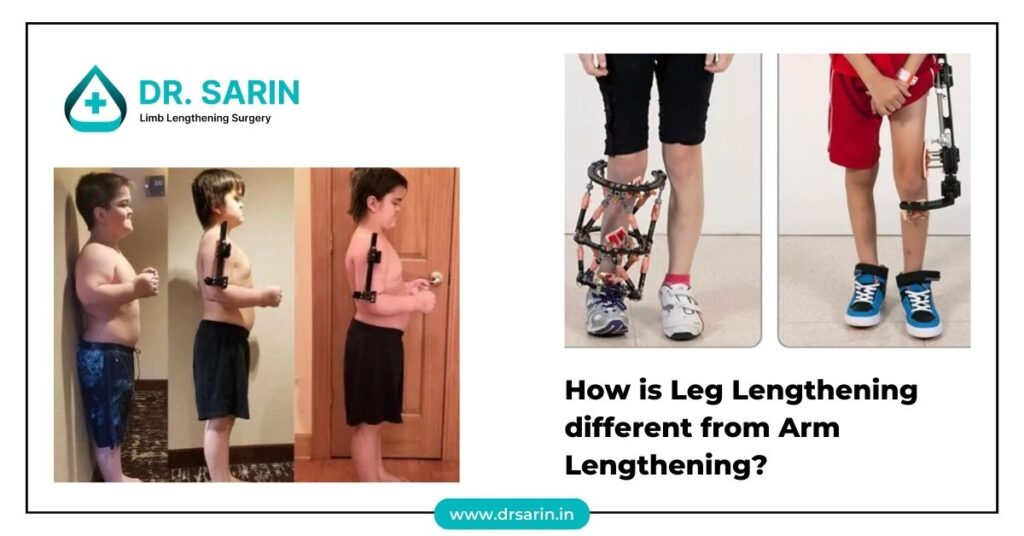
Leg lengthening and arm lengthening are both complex medical procedures aimed at increasing the length of limbs. However, they differ significantly in terms of techniques, applications, recovery, and outcomes. Below, we delve into the distinctions between these two types of surgeries. Techniques and Procedures Leg lengthening is primarily performed using methods such as the Ilizarov technique or the Precise nail system. These involve the surgical breaking of the bone (typically the femur or tibia) and the gradual separation of the bone segments, allowing new bone to form in the gap. This process is often performed to correct discrepancies in leg length or for cosmetic height enhancement. Arm lengthening, on the other hand, is far less common and usually reserved for correcting significant congenital anomalies or after severe trauma. The techniques used can be similar, involving the cutting of the humerus or forearm bones and slowly extending them. However, due to the complex structure of the arm and its essential functions, this surgery is considered more delicate and less prevalent. Applications and Reasons for Surgery The reasons behind leg and arm lengthening surgeries also differ significantly. Leg lengthening is often sought by individuals looking to increase their height for cosmetic reasons or to correct leg length discrepancies that result from congenital disabilities, disease, or injury. These discrepancies can lead to posture issues, pain, and reduced mobility. In contrast, arm lengthening is typically undertaken for more severe medical conditions such as significant asymmetry due to congenital disabilities, growth disturbances, or reconstructive needs following trauma. It is rarely performed for cosmetic reasons. Recovery and Rehabilitation The recovery process for leg lengthening can be lengthy and painful, often taking several months. Patients need to undergo rigorous physiotherapy to maintain muscle strength and flexibility while the bones are lengthening and healing. The process requires patience and dedication, as improper care can lead to complications such as bone infection or misalignment. Arm lengthening recovery, while also challenging, involves a different set of challenges, including maintaining the complex range of motion needed in the arm and hand. Rehabilitation focuses on restoring function and strength while ensuring the lengthened limb heals correctly. Risks and Outcomes Both procedures come with risks such as infection, nerve damage, and the possibility of further surgery. However, the outcomes can be life-changing. Leg lengthening can result in increased height and improved balance, gait, and overall physical appearance. Arm lengthening can significantly improve the functional use of the arm and hand, but it is often more focused on achieving symmetry and functionality rather than length alone. While both leg and arm lengthening surgeries aim to improve patients’ lives by enhancing the length and function of their limbs, they differ in terms of their applications, techniques, recovery processes, and typical outcomes. These differences highlight the specialized nature of each procedure and the importance of a tailored approach to patient care.
How active can children be after limb lengthening?

Limb-lengthening is a significant medical procedure that can address discrepancies in limb lengths and improve the quality of life for children with these differences. As technology and surgical techniques have advanced, the outcomes for limb lengthening have continued to improve, offering children and their families new hope and opportunities. However, a common concern among parents and caregivers is understanding how active children can be after undergoing surgery. Post-Surgery Recovery Phase The initial phase after surgery is critical for recovery. During this time, children are generally advised to limit physical activity to ensure proper healing. The focus is on managing pain, preventing infection, and starting gentle physical therapy. It’s essential for the healing process that activity levels are increased gradually under the guidance of healthcare professionals. Physical Therapy and Rehabilitation Physical therapy is a cornerstone of post-operative care in limb-lengthening procedures. Children will work with physiotherapists to gradually increase the strength and flexibility of their lengthened limbs. As their recovery progresses, the intensity and variety of exercises will increase. Physical therapy is tailored to each child’s specific needs and is crucial for regaining full function. Gradual Return to Activity As children heal and adapt to their new limb length, they can gradually return to more active play. However, the timeline for this return can vary widely depending on the extent of the surgery, the child’s overall health, and how well they are progressing with physical therapy. It’s crucial to follow the guidance of the child’s medical team, who will provide clear instructions on what activities are safe and at what stages of recovery. Monitoring and Adjusting Activity Levels It’s important to monitor a child’s activity levels and watch for signs of overexertion or discomfort, which could indicate that they are pushing themselves too hard. Parents and caregivers should ensure that children take regular breaks and do not overdo it, even if they feel capable. The body needs time to adjust to changes in limb length and to heal properly. Long-Term Activity and Participation In Sports Most children can return to a wide range of activities once they have fully recovered from limb-lengthening surgery. However, they may need to wait several months to a year before engaging in high-impact sports or activities that put significant stress on the lengthened limb. Each child’s case is unique, and ongoing consultations with healthcare providers will determine when it’s safe to resume these activities. Emotional and Social Considerations Apart from physical limitations, children recovering from limb lengthening may also face emotional and social challenges. Parents and caregivers need to supportIt’s their child’s mental well-being, encouraging them to stay positive and engaged with their friends and hobbies as much as possible. This support can play a crucial role in their overall recovery and return to activity. Conclusion Limb lengthening Surgery can significantly impact a child’s life, not just physically but also emotionally and socially. While the recovery process requires patience and adherence to medical advice, most children can look forward to returning to an active, fulfilling life after their recovery. Regular check-ups, a dedicated physical therapy regimen, and supportive care are essential to ensure a successful outcome. By understanding and respecting the limits of their recovery, children can gradually return to the activities they love, potentially with greater ease and ability than before.
What types of devices are used for limb lengthening?
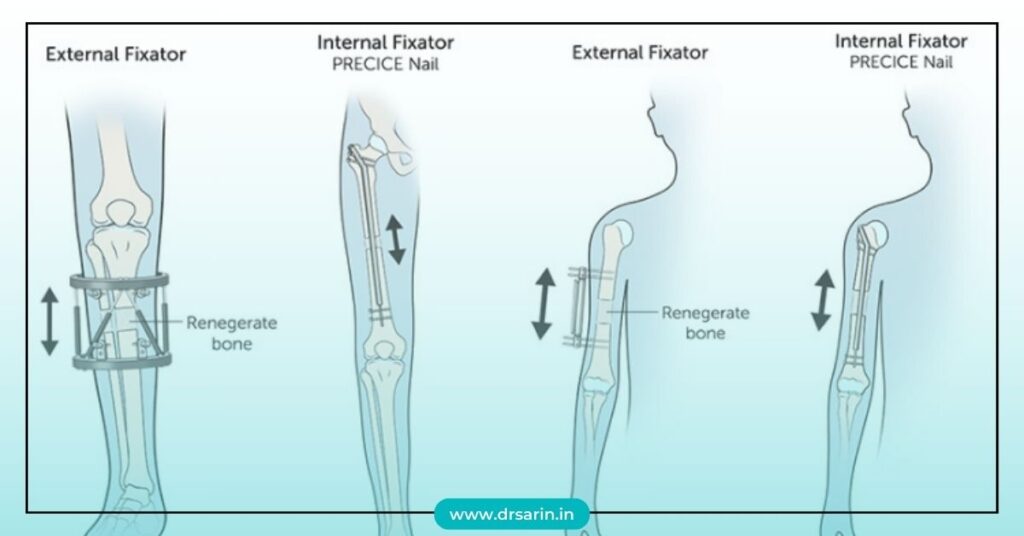
It is a complex orthopaedic procedure aimed at correcting limb length discrepancies or deformities. This innovative surgical technique involves gradually elongating bones using external or internal fixation devices. Several types of devices are utilized in Limb Lengthening Surgery to achieve the desired results effectively and safely. Here are some common types: 1. External Fixators: External fixators are devices placed outside the body and attached to the affected limb with pins or wires. These fixators consist of metal rings connected by adjustable rods. The surgeon makes precise adjustments to the fixator to gradually stretch the bone over time, stimulating new bone growth. 2. Internal Lengthening Nails: Internal lengthening nails are implanted inside the bone and are less visible compared to external fixators. These devices have a telescopic design, allowing for controlled distraction of the bone segments. Internal lengthening nails are particularly beneficial for patients who prefer a more discreet option or have cosmetic concerns. 3. Intramedullary Rods: Intramedullary rods are inserted into the hollow centre of the bone to support and stabilize it during lengthening. These rods may contain telescopic components or adjustable screws to facilitate gradual bone distraction. Intramedullary rods are commonly used for limb lengthening in the femur or tibia. 4. Circular Frames: Circular frames consist of rings connected by wires or rods and are placed around the limb. Unlike traditional external fixators, circular frames provide multidirectional stability, allowing for more precise control over the bone’s alignment and length. These frames are often used in complex cases or revision surgeries. 5. Precice® Nail System: The Precice® Nail System is a modern internal lengthening device equipped with a remote-controlled magnetic mechanism. This innovative system enables patients to perform bone lengthening at home under the guidance of their healthcare provider, reducing the need for frequent clinic visits. This surgery employs a variety of devices tailored to the individual needs of patients. Whether using external fixators, internal lengthening nails, intramedullary rods, circular frames, or advanced systems like the Precice® Nail, orthopaedic surgeons can effectively correct limb length discrepancies and improve patients’ quality of life.
Internal Lengthening Device for Limb Lengthening Surgery
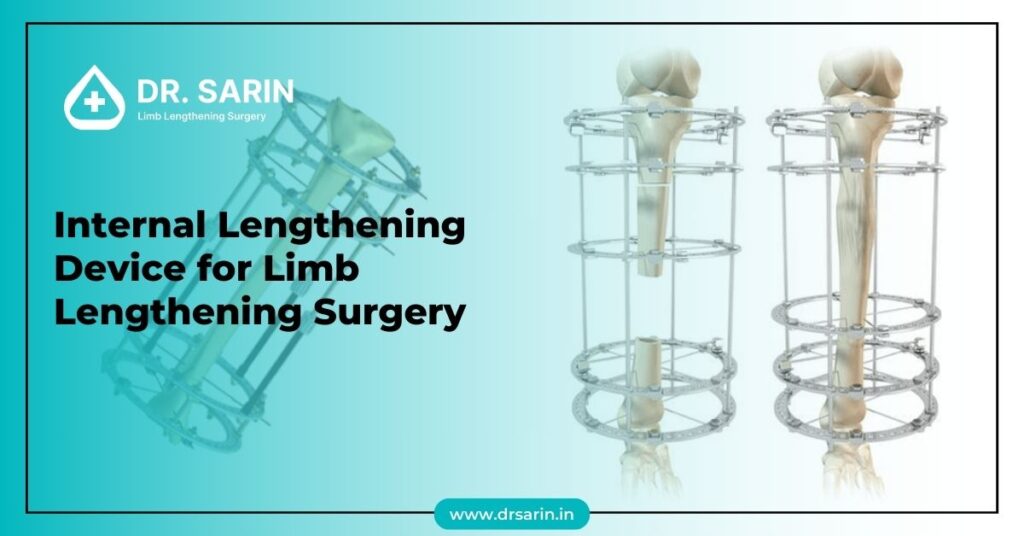
Limb lengthening surgery using an internal lengthening device is a sophisticated procedure designed to address various orthopedic conditions and improve the quality of life for individuals with limb length discrepancies. Here’s everything you need to know about this innovative approach: Why Is Limb Lengthening Surgery With an Internal Lengthening Device Done? This surgery with an internal lengthening device is typically performed to correct limb length inequalities resulting from congenital conditions, trauma, infections, or skeletal deformities. This procedure aims to restore symmetry and function to the limbs, alleviate pain, improve mobility, and enhance overall physical appearance. What Is an Internal Lengthening Device? An internal lengthening device, also known as an intramedullary nail or implant, is a specialized orthopedic device surgically implanted inside the bone to facilitate controlled limb lengthening. These devices consist of telescopic rods, screws, and locking mechanisms that allow gradual distraction of the bone segments, promoting new bone formation and lengthening over time. What Happens During Limb Lengthening Surgery? During surgery, the orthopedic surgeon makes precise incisions to access the affected bone. The internal lengthening device is then inserted into the bone marrow cavity and secured in place with screws or pins. Once the device is in position, the surgeon initiates the distraction process by activating the lengthening mechanism within the device. Over several weeks to months, the bone gradually elongates as new bone tissue forms in the gap created by the distraction. How Should We Prepare for Limb Lengthening Surgery? Before undergoing surgery, patients undergo a comprehensive evaluation to assess their overall health and suitability for the procedure. This evaluation may include a medical history review, physical examinations, imaging studies (such as X-rays or MRI scans), and consultations with orthopedic specialists. Patients may also receive preoperative instructions regarding lifestyle modifications, medication adjustments, and postoperative care preparations. What Else Should I Know? While surgery with an internal lengthening device offers significant benefits, it’s essential to understand that the process requires patience, dedication, and meticulous postoperative care. Following surgery, patients undergo a period of distraction and consolidation, during which they must adhere to a prescribed regimen of physical therapy, rehabilitation exercises, and regular follow-up appointments with their orthopedic team. Additionally, potential risks and complications associated with the procedure, such as infection, nerve injury, or device malfunction, should be discussed thoroughly with the surgical team prior to surgery. In conclusion, This surgery with an internal lengthening device represents a remarkable advancement in orthopedic medicine, offering a safe and effective solution for correcting limb length inequalities and enhancing functional outcomes. By understanding the purpose of the procedure, the role of internal lengthening devices, the surgical process, and the importance of preparation and postoperative care, patients can make informed decisions and achieve successful outcomes in their journey toward improved limb function and quality of life.
Consultation, Travel Arrangements, and Preparatory Guidelines for Limb Lengthening Surgery
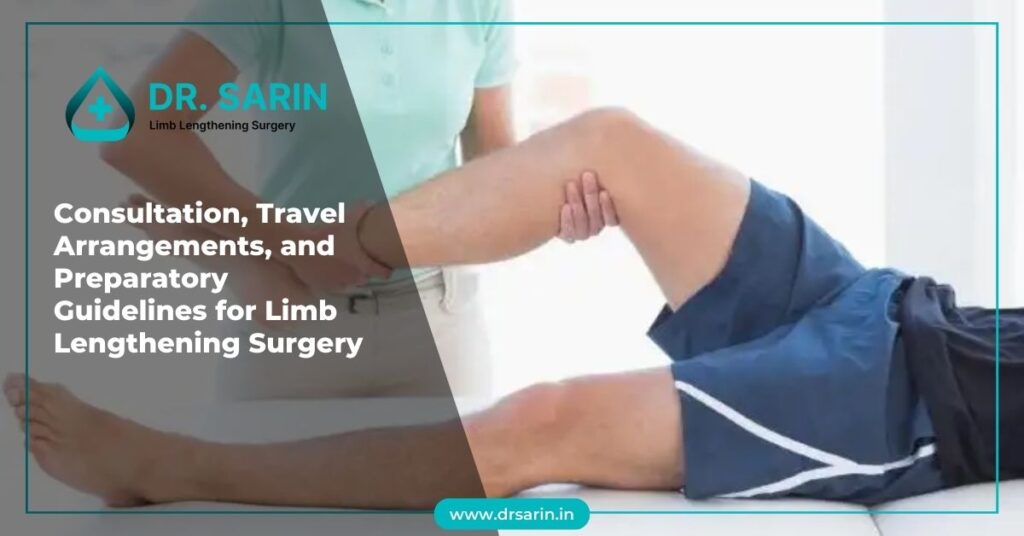
Limb lengthening surgery is a significant medical procedure that requires thorough preparation and planning. From the initial consultation to post-surgery recovery, every step of the process plays a crucial role in ensuring a successful outcome. In this guide, we’ll outline the key aspects of preparing for limb-lengthening surgery, including research and consultation, travel arrangements, and preparatory guidelines. Research and Consultation: Starting Your Journey Before embarking on the limb-lengthening surgery journey, it’s essential to conduct thorough research and schedule consultations with experienced orthopedic surgeons. During these consultations, you’ll discuss your medical history, goals, and expectations for the surgery. It’s also an opportunity to ask any questions you may have and gain a better understanding of the procedure and its potential risks and benefits. Planning Your Travel Depending on your location and the availability of specialized surgeons, you may need to travel for limb-lengthening surgery. It’s essential to plan your travel arrangements well in advance, including booking flights, accommodations, and transportation to and from the hospital or clinic. Consider factors such as proximity to medical facilities and accessibility for post-surgery mobility. Preparing for Your Surgery In the weeks leading up to your surgery, there are several preparatory steps you’ll need to take. This includes following your surgeon’s instructions regarding pre-operative tests and medical evaluations, as well as any dietary or medication restrictions. You may also need to arrange for someone to accompany you to the hospital on the day of the surgery and assist with postoperative care. Preparing for What Comes After Surgery Recovery from limb lengthening surgery can be a lengthy process, requiring patience and commitment. Before the surgery, it’s essential to prepare your home environment for optimal comfort and mobility during the recovery period. This may involve purchasing or renting medical equipment such as crutches or wheelchairs and making arrangements for home care assistance if needed. Final Preparation Checklist for Limb Lengthening Surgery By following these preparatory guidelines and checklist items, you can ensure that you’re fully prepared for limb-lengthening surgery and set yourself up for a successful recovery journey. Remember to communicate openly with your medical team and seek support from loved ones as needed throughout the process.
Selecting the Ideal Limb Lengthening Approach: Comparing Femur and Tibia Lengthening
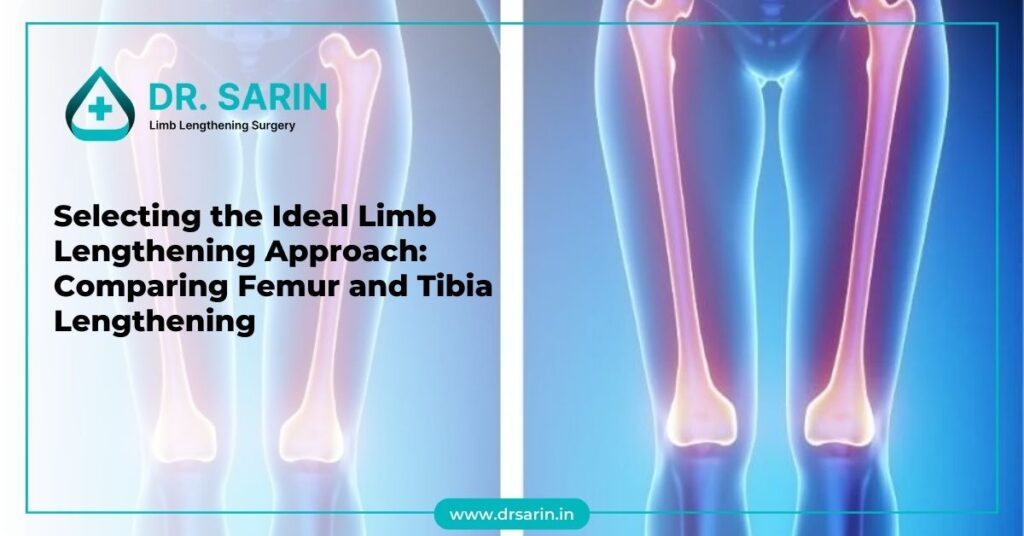
Deciding to undergo limb-lengthening surgery is a significant step towards achieving desired height or correcting limb length discrepancies. However, selecting the ideal approach between femur and tibia lengthening requires careful consideration of various factors, including individual goals, medical history, and surgical options available. With advancements in orthopedic techniques and technologies, patients now have access to innovative procedures like Precise Max (formerly Stryde), Precice 2, and the LON method, offering improved outcomes and enhanced patient experiences. In this guide, we will explore the differences between femur and tibia lengthening, weigh the pros and cons of each approach, and discuss various lengthening options available to help patients make informed decisions about their limb-lengthening journey. Limb-Lengthening Methods and Their Outcomes Limb-lengthening procedures have evolved significantly over the years, offering patients improved outcomes and shorter recovery times. Among the various methods available, Precise Max (formerly Stryde), Precice 2, and the LON method stand out as popular choices for achieving desired limb lengthening. Precise Max (Formerly Stryde) Precise Max, previously known as Stryde, utilizes an advanced intramedullary nail system with motorized lengthening capabilities. This method allows for precise control over the lengthening process, resulting in more predictable outcomes and reduced risks of complications. Precice 2 The Precise 2 system employs a remote-controlled magnetic mechanism to gradually lengthen the bone, offering patients greater convenience and flexibility during the lengthening process. With its innovative technology, Precise 2 has become a preferred option for many individuals seeking limb-lengthening procedures. LON Method The LON (Lengthening Over Nail) method involves the insertion of an external fixator over an existing intramedullary nail, providing stability and support during the lengthening process. This technique offers a combination of internal and external fixation, allowing for controlled bone growth and enhanced patient comfort. Femur vs. Tibia Lengthening When considering limb-lengthening procedures, patients often face the choice between femur and tibia lengthening, each with its own set of benefits and considerations. Femur Lengthening: Pros and Cons Femur lengthening typically allows for greater length gains compared to tibia lengthening. However, the procedure may involve a longer recovery time and increased risk of complications such as hip and knee stiffness. Tibia Lengthening: Pros and Cons Tibia lengthening is generally associated with shorter recovery times and reduced risk of joint stiffness. However, the maximum length gains achievable may be less than those with femur lengthening. Your Lengthening Options Patients considering limb-lengthening procedures have several options to choose from, depending on their individual needs and goals. Option 1 – Bilateral Femur Lengthening Maximum Lengthening Amount: 8-10 cm / 3.25-4 inches Option 2 – Bilateral Tibia Lengthening Maximum Lengthening Amount: 5-7 cm / 2-2.75 inches Option 3 – Sequential Lengthening of Femur and Tibia Maximum Lengthening Amount: 14-17 cm / 5.5-6.7 inches Option 4 – Quadrilateral Lengthening of Femur and Tibia Maximum Lengthening Amount: 13-15 cm / 5.1-5.9 inches How Can I Choose the Best Option For Me? Selecting the most suitable limb-lengthening option requires careful consideration of factors such as desired length gains, recovery time, potential risks, and individual preferences. Consulting with a qualified orthopedic surgeon specializing in limb-lengthening procedures is essential to assess candidacy and develop a personalized treatment plan tailored to your specific needs and goals. By weighing the pros and cons of each approach and discussing your concerns with your healthcare provider, you can make an informed decision and embark on your journey toward achieving optimal limb length and function.
Tips for Preserving Mobility and Easing Pain In Elderly Individuals with Arthritis
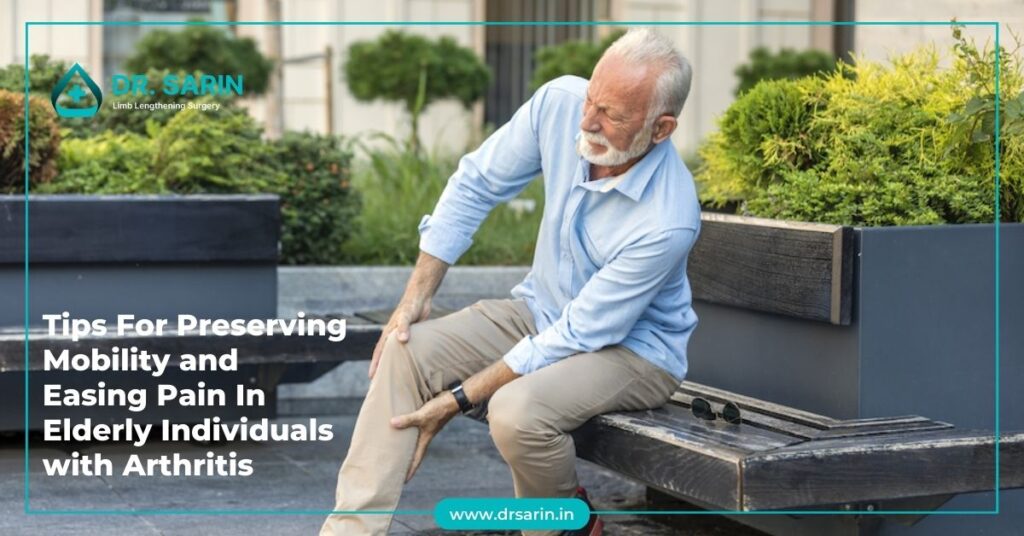
Arthritis is a common condition that affects millions of elderly individuals worldwide, causing pain, stiffness, and reduced mobility. Managing Arthritis effectively is crucial for maintaining quality of life and independence in older adults. Here are some tips for preserving mobility and easing pain in elderly individuals with Arthritis: Impact on the Elderly Arthritis can have a significant impact on the daily lives of elderly individuals, making simple tasks like walking, climbing stairs, and getting out of bed challenging. The pain and stiffness associated with Arthritis can also affect sleep quality and overall well-being, leading to decreased physical activity and social isolation. 10 Tips for Seniors to Manage Arthritis By incorporating these tips into their daily routine, elderly individuals with Arthritis can preserve mobility, ease pain, and improve their overall quality of life. Encourage seniors to take an active role in managing their arthritis symptoms and seek support from healthcare professionals as needed to optimize their health and well-being.
Guide to the Initial 10 Days Following Leg Lengthening Surgery

Undergoing leg lengthening surgery marks the beginning of a transformative journey towards improved mobility and quality of life. The initial 10 days following the procedure are critical for laying the foundation for successful recovery and rehabilitation. From arrival in Gurugram to the commencement of physiotherapy and exercise programs, each day is meticulously planned to optimize healing and ensure the best possible patient outcomes. In this guide, we’ll walk through the step-by-step process of the first 10 days following leg lengthening surgery and provide insights into the subsequent phases of lengthening and recovery. By understanding what to expect during each stage, patients can approach their recovery journey with confidence and determination, knowing that a comprehensive and structured rehabilitation program supports them. Initial 10 Days After Surgery Undergoing leg lengthening surgery is a significant medical procedure that requires careful postoperative care and rehabilitation. The initial 10 days following surgery are crucial for ensuring a smooth recovery and laying the foundation for the lengthening process. Day 1: Arrival In Gurugram and rest at the rehab centre Upon arrival in Gurugram, you will be admitted to the rehabilitation centre where you will rest to recuperate from the journey and prepare for the upcoming surgery. Day 2: Meeting with the Doctor, examination, and preoperative tests On the 2nd day, you will meet your Doctor for a comprehensive examination and preoperative tests to assess your overall health and readiness for surgery. Day 3: Surgery day Day 3 marks the day of your leg lengthening surgery. A team of skilled surgeons will perform the surgical procedure using advanced techniques to achieve the desired lengthening goals. Day 4: Post-surgery care in the hospital room Following surgery, you will be transferred to a hospital room where you will receive postoperative care and monitoring to ensure a smooth recovery. Pain management and infection prevention measures will be implemented during this time. Day 5: Getting back on your feet By day 5, you will begin getting back on your feet with the assistance of healthcare professionals. Physical therapy and mobility exercises will be initiated to promote circulation and prevent complications such as blood clots. Day 6-7: Rehabilitation in the hospital Day 6 will involve continued rehabilitation efforts in the hospital, focusing on strengthening exercises, range of motion activities, and pain management strategies to facilitate recovery. Rehabilitation efforts will continue on day 7, focusing on increasing mobility and independence. Occupational therapy may also be introduced to assist with activities of daily living. Day 8: First lengthening On day 8, the first lengthening procedure may be performed, depending on the specific surgical plan and recovery progress. This step marks the beginning of the lengthening process and requires careful monitoring and adjustment. Day 9: Discharge from hospital By day 9, you may be ready for discharge from the hospital, depending on your progress and the recommendation of your healthcare team. Instructions for at-home care and follow-up appointments will be provided before discharge. Day 10: Beginning of physiotherapy and exercise program Day 10 marks the beginning of your at-home physiotherapy and exercise program, which will be crucial for promoting healing, strengthening muscles, and maximizing your range of motion as you continue your recovery journey. Beyond: Lengthening and Recovery Process Beyond the initial 10 days, the lengthening and recovery process will continue according to a structured timeline: During this time, you will work closely with your healthcare team to monitor progress, adjust treatment plans as needed, and achieve optimal outcomes regarding leg lengthening and functional recovery. With dedication to rehabilitation and adherence to medical guidance, you can expect a successful recovery and improved quality of life following leg lengthening surgery. If you have any questions or need further information about surgery, please don’t hesitate to contact us for a free consultation. We are here to support you every step of the way.

